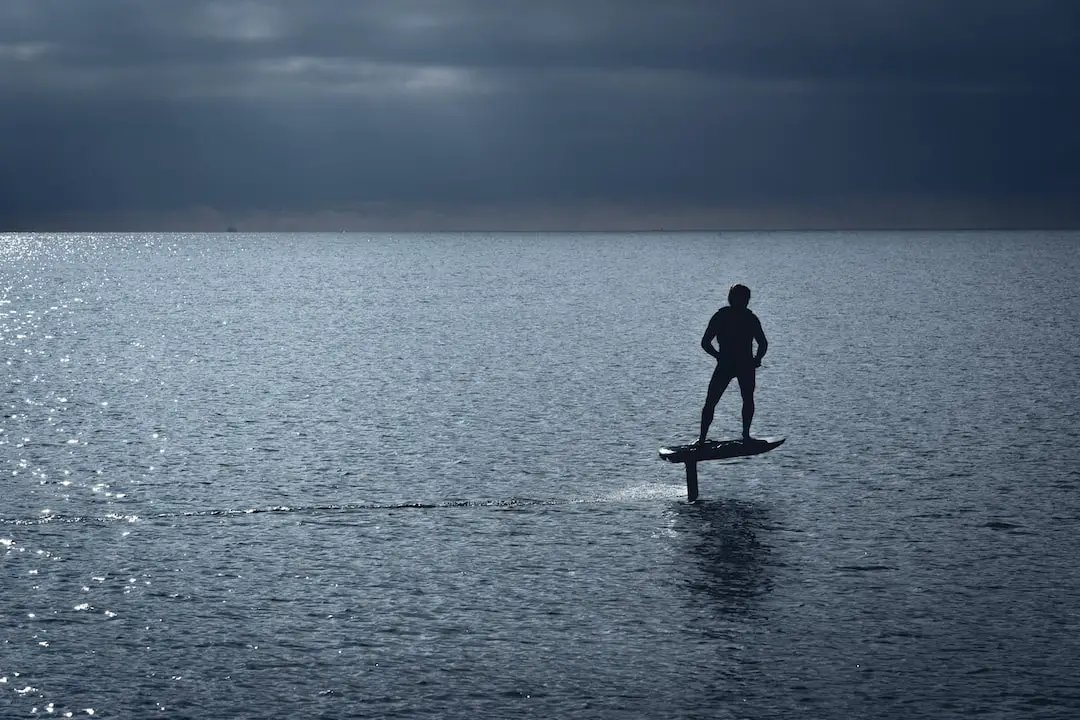Support our hydrofoil educational content for free when you purchase through links on our site. Learn more
How to Hydrofoil: The Ultimate Guide [2024]
Have you ever watched a surfer gracefully glide across the water, defying gravity on a hydrofoil board? It’s a mesmerizing sight, and you might be wondering how you can experience the thrill of hydrofoiling for yourself. Well, you’re in luck! In this comprehensive guide, we’ll take you through everything you need to know about hydrofoiling, from the basics to advanced techniques. So grab your wetsuit and get ready to ride the waves like never before!
Table of Contents
- Quick Answer
- Quick Tips and Facts
- Background and History of Hydrofoiling
- Getting Started: The Basics of Hydrofoiling
- Choosing the Right Hydrofoil Equipment
- Mastering Advanced Hydrofoiling Techniques
- Hydrofoiling Behind a Boat
- FAQ
- Conclusion
- Recommended Links
- Reference Links
Quick Answer
Hydrofoiling is a thrilling water sport that involves riding a specially designed board equipped with a hydrofoil, which lifts the board out of the water as you gain speed. This creates a smooth and effortless glide, allowing you to ride waves with incredible speed and stability. Hydrofoiling requires practice and balance, but with the right technique and equipment, anyone can learn to hydrofoil and experience the exhilaration of flying above the water.
To get started with hydrofoiling, you’ll need a hydrofoil board, a foil mast, and a foil wing. These components work together to lift the board out of the water and provide stability. Once you have your equipment, you’ll need to learn the proper technique for getting up on the foil and maintaining your balance. It may take some time to master, but with practice, you’ll be soaring above the water in no time.
CHECK PRICE on: Hydrofoil Boards | Foil Masts | Foil Wings
Quick Tips and Facts
Before we dive deeper into the world of hydrofoiling, here are some quick tips and interesting facts to get you excited:
- Hydrofoiling is not limited to surfing. It can be done on a variety of watercraft, including kiteboards, windsurfers, and even stand-up paddleboards.
- Hydrofoiling allows you to ride waves that are too small for traditional surfing, opening up a whole new world of possibilities.
- The hydrofoil creates lift by generating a pressure difference between the upper and lower surfaces of the wing, similar to how an airplane wing works.
- Hydrofoiling can reach speeds of up to 30 miles per hour, making it one of the fastest water sports.
- The feeling of gliding above the water on a hydrofoil board is often described as “flying” or “levitating.”
Now that you have a taste of what hydrofoiling is all about, let’s take a closer look at its background and history.
Background and History of Hydrofoiling

Hydrofoiling has a rich history that dates back to the early 20th century. The concept of using hydrofoils to lift boats out of the water and reduce drag was first explored by Italian engineer Enrico Forlanini in the late 1800s. However, it wasn’t until the 1950s that hydrofoiling gained popularity as a recreational water sport.
In the early days, hydrofoils were primarily used in military and commercial applications. The first hydrofoil boats were developed for the military to increase speed and maneuverability. These early hydrofoils were large and complex, with multiple foils and engines.
It wasn’t until the 1970s that hydrofoiling started to make its way into the world of surfing. Surfers began experimenting with hydrofoil attachments on their surfboards, allowing them to ride waves with increased speed and stability. Over the years, hydrofoil technology has evolved, and dedicated hydrofoil boards have been developed to optimize performance and maneuverability.
Today, hydrofoiling has become a popular water sport, attracting surfers, kiteboarders, and water sports enthusiasts from around the world. The advancements in hydrofoil design and technology have made it more accessible and easier to learn, allowing beginners to experience the thrill of hydrofoiling with less effort.
Getting Started: The Basics of Hydrofoiling
Now that you have a basic understanding of hydrofoiling, let’s dive into the essential techniques and skills you need to get started.
1. Choosing the Right Hydrofoil Board
The first step in getting started with hydrofoiling is choosing the right board. Hydrofoil boards are specifically designed to work with the hydrofoil system and provide stability and control. When selecting a hydrofoil board, consider factors such as your skill level, weight, and the type of waves you’ll be riding.
CHECK PRICE on: Hydrofoil Boards
2. Assembling Your Hydrofoil Equipment
Once you have your hydrofoil board, you’ll need to assemble the hydrofoil system. This includes attaching the foil mast and wing to the board. Make sure to follow the manufacturer’s instructions carefully to ensure proper installation and alignment.
3. Mastering the Takeoff
The takeoff is one of the most critical aspects of hydrofoiling. To get up on the foil, start by paddling into a wave with your board parallel to the shore. As the wave approaches, paddle hard and pop up onto your feet, keeping your weight centered and your eyes focused on the horizon. As you gain speed, the hydrofoil will generate lift, and the board will rise out of the water.
4. Finding Your Balance
Maintaining your balance is key to staying on the hydrofoil. Keep your weight centered and your body relaxed. Use small adjustments in your body position and foot pressure to control the direction and speed of the board. It may take some time to find your balance, so be patient and keep practicing.
5. Riding the Waves
Once you’re comfortable on the hydrofoil, it’s time to start riding the waves. Look for waves with a clean face and a gradual slope. As you approach the wave, use your body and foot pressure to control the pitch and roll of the board. Stay relaxed and let the hydrofoil do the work. With practice, you’ll be able to ride waves with incredible speed and stability.
Choosing the Right Hydrofoil Equipment
Choosing the right hydrofoil equipment is crucial for a successful and enjoyable hydrofoiling experience. Here are some factors to consider when selecting your hydrofoil equipment:
1. Foil Mast Length
The length of the foil mast determines the height at which your board will ride above the water. Longer masts provide more clearance and are ideal for riding in choppy or shallow water. Shorter masts offer better maneuverability and are suitable for riding in smaller waves.
2. Foil Wing Size
The size of the foil wing affects the lift and stability of the hydrofoil. Larger wings provide more lift and stability, making them suitable for beginners and riding in smaller waves. Smaller wings offer increased maneuverability and are ideal for more experienced riders and larger waves.
3. Board Volume and Shape
The volume and shape of the hydrofoil board play a significant role in its stability and performance. Boards with higher volume provide more buoyancy and stability, making them easier to learn on. Narrower boards offer better maneuverability and are suitable for more advanced riders.
4. Materials and Construction
Hydrofoil equipment is typically made from lightweight and durable materials such as carbon fiber and fiberglass. These materials offer excellent strength-to-weight ratios and enhance the performance of the hydrofoil. Look for equipment that is built to withstand the rigors of hydrofoiling and can handle the demands of your riding style.
CHECK PRICE on: Hydrofoil Boards | Foil Masts | Foil Wings
Mastering Advanced Hydrofoiling Techniques
Once you’ve mastered the basics of hydrofoiling, you can start exploring more advanced techniques and maneuvers. Here are a few techniques to take your hydrofoiling skills to the next level:
1. Pumping
Pumping is a technique used to generate speed and maintain momentum without relying solely on waves. By shifting your weight and using small, rhythmic movements, you can create lift and generate forward motion. Pumping requires precise timing and coordination, so be prepared to practice and experiment.
2. Carving Turns
Carving turns on a hydrofoil board is a thrilling experience. By shifting your weight and using subtle foot pressure, you can initiate smooth and controlled turns. Start with gentle turns and gradually increase the angle and speed as you become more comfortable. Remember to keep your body relaxed and your eyes focused on the direction you want to go.
3. Jumping
Jumping on a hydrofoil board adds an extra element of excitement to your ride. To jump, build up speed and use a small wave or a bump in the water to launch yourself into the air. Keep your body centered and your eyes focused on the landing spot. As you descend, use your body and foot pressure to absorb the impact and maintain control.
Hydrofoiling Behind a Boat
Hydrofoiling behind a boat is a popular variation of hydrofoiling that allows you to experience the thrill of hydrofoiling without relying on waves. Here are the basic steps to get started:
- Attach the hydrofoil to your board following the manufacturer’s instructions.
- Attach a tow rope to the boat’s tow point and secure it to your hydrofoil board.
- Get into the water and position yourself with the board parallel to the boat.
- Signal the boat driver to start slowly, and as you gain speed, the hydrofoil will generate lift, lifting you out of the water.
- Use your body and foot pressure to control the direction and speed of the board.
- Enjoy the ride and experiment with different maneuvers and tricks.
Hydrofoiling behind a boat offers a unique and exhilarating experience, allowing you to ride for extended periods and explore new areas without the need for waves.
FAQ

How do you hydrofoil for beginners?
For beginners, hydrofoiling can seem intimidating, but with the right technique and equipment, anyone can learn to hydrofoil. Start by choosing the right hydrofoil board and assembling your hydrofoil system. Practice the takeoff technique and focus on maintaining your balance. Start on small waves and gradually work your way up to larger waves as you gain confidence. Remember to be patient and persistent, as hydrofoiling takes time to master.
Read more about “15 Tips to Master Hydrofoiling Behind a Boat | Beginner’s Guide …”
How hard is it to hydrofoil?
Hydrofoiling requires practice and balance, but with dedication and the right equipment, it is achievable for most people. The learning curve can vary depending on your previous experience with water sports and your ability to adapt to new techniques. It’s important to start with the basics and gradually progress as you gain confidence and skill. Don’t be discouraged if it takes time to get the hang of hydrofoiling – the rewards are well worth the effort.
Read more about “How to Ride a Hydrofoil Behind a Boat: Mastering the Art of Hydrofoil Boarding …”
Can you hydrofoil without waves?
Yes, you can hydrofoil without waves by using a boat or a kite to generate the necessary speed and lift. Hydrofoiling behind a boat or using a kite allows you to experience the thrill of hydrofoiling in flat water conditions. This opens up a whole new world of possibilities and allows you to ride for extended periods without relying on waves.
Read more about “Can you hydrofoil without waves?”
How do you ride a hydrofoil behind a boat?
To ride a hydrofoil behind a boat, you’ll need a hydrofoil board, a hydrofoil system, and a tow rope. Attach the hydrofoil to your board and secure the tow rope to the boat’s tow point. Get into the water with the board parallel to the boat and signal the boat driver to start slowly. As you gain speed, the hydrofoil will generate lift, lifting you out of the water. Use your body and foot pressure to control the direction and speed of the board. Enjoy the ride and experiment with different maneuvers and tricks.
Read more about “How do you ride a hydrofoil behind a boat?”
Conclusion

Hydrofoiling is a thrilling water sport that offers a unique and exhilarating experience. By riding a hydrofoil board equipped with a hydrofoil, you can glide above the water with incredible speed and stability. While hydrofoiling may take some time to master, with the right technique and equipment, anyone can learn to hydrofoil and experience the joy of flying above the water.
After exploring the basics of hydrofoiling, choosing the right equipment, and mastering advanced techniques, you’ll be well on your way to becoming a skilled hydrofoiler. Remember to practice regularly, be patient with yourself, and always prioritize safety.
So what are you waiting for? Dive into the world of hydrofoiling and discover the thrill of riding waves like never before!
Recommended Links
- CHECK PRICE on: Hydrofoil Boards | Foil Masts | Foil Wings
- Shop Hydrofoil Equipment on: Amazon | Walmart | Etsy
- Hydrofoil Basics
- Hydrofoil Equipment Reviews
- Advanced Hydrofoiling Techniques
- Hydrofoil History
- Hydrofoiling Behind a Boat




